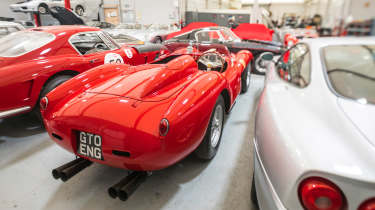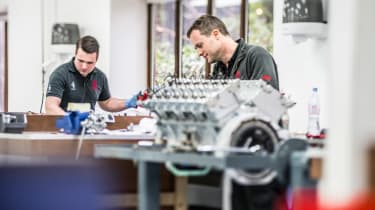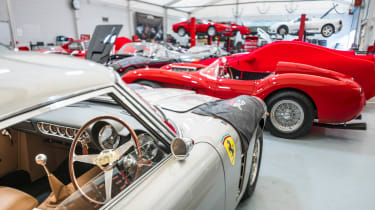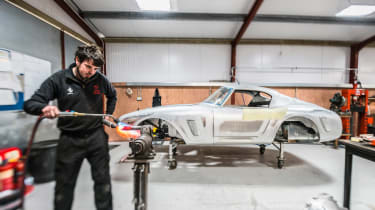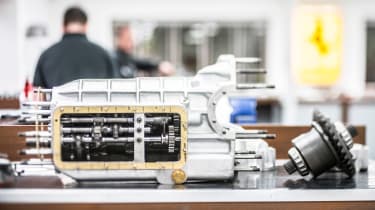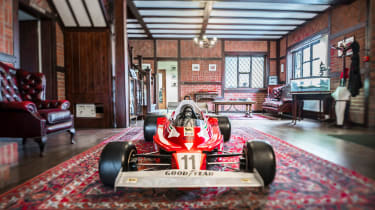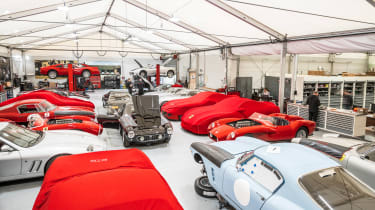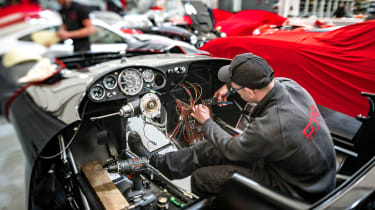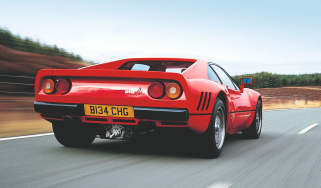GTO Engineering – inside the UK's Ferrari specialist
Don’t be fooled by the stately surroundings; GTO Engineering is one of the most dynamic and innovative Ferrari specialists in the world
Mark Lyon’s family business, GTO Engineering, is in rude health. It has around 50 very keen employees, most of them at the company’s main hub in Twyford, just east of Reading. It’s a leading authority on Ferraris with Colombo V12s, to the extent that it even makes brand new engines (and brand new Colombo-powered cars, but we’ll come to that), but it services, repairs and restores all classic Ferraris. And, lately, modern ones, too.
Thus do the activities of this specialist and of today’s official Ferrari dealers show the first signs of common ground. The factory is encouraging its dealers to take on classic-car work and training staff accordingly, even while companies such as GTO need good relations with the factory like never before.
This new approach contrasts with the factory’s past indifference to anything old, but Mark stresses the value of experience. ‘The staff are always the biggest problem,’ he says. ‘You can’t train someone on classic Ferraris in just two years. It takes six years, maybe eight.’
> Ferrari F40 vs 288 GTO - turbocharged icons go head-to-head
Certainly everyone seems to know exactly what they’re doing on the day of our visit, including a couple of technicians who rally a brace of 308 GTBs in their spare time. After passing through the entrance hall of the grand house that fronts the business, and spying the child-size Ferrari F1 car (‘I bought it at auction by mistake,’ Mark reveals), we arrive in the engine workshop run by Mark’s son, Jerry.
‘We build complete new units,’ explains recently arrived marketing man Chris Rowles, ‘so that owners can keep the original ones safe. So we have new blocks and heads cast for us, and we make everything else or have it made.’ Jerry points to a rebuilt engine for a 250 GTO. ‘It’s the original engine – 3 litres and 285bhp – which will stay on a stand for a bit now. The car itself has a new 4-litre engine.’
Another new 250 engine is in the process of being built up, destined for the 16th 250 GT SWB to be made. This one retains the original bore size and 3-litre capacity. I’m reminded once again of how amazingly compact this Colombo V12 aluminium block is, and how short the stroke of the pistons within.
Chris and I now head outside, across the yard to the main car workshop. It’s filled practically to capacity. There’s a Daytona just being warmed up, a couple of modern Ferraris in mid-service, and more 250 GT SWBs and Testa Rossas than I’ve ever seen before in one place.
Here’s a silver 250 GT, the car that won the 1960 Tour de France. And here’s a black one, looking just as it must have looked as it drove out of Maranello’s factory gates the first time. Except that this one, or at least most of it, was never there: it’s a new car, or as good as, built right here by GTO Engineering. A couple of similarly freshly minted siblings are nearby, along with ‘new’ TRs looking as luscious as the original one also present.
> Ferrari Testarossa review, history and specs: TR generations driven back-to-back
‘The idea stemmed from the engineering and parts departments,’ Chris explains. ‘If a client has the chassis of a “lesser” or damaged Ferrari, it can be rebuilt as a 250 SWB or TR.’
Workshop manager Kevin Jones, who has been with GTO Engineering since it started 25 years ago, adds some background. ‘People were starting not to use their original 250 GT SWBs, because they were worried about wrecking their engines. So we started changing the engines and ran out of them.
‘Ferrari wasn’t interested in making any more, so we made our own,’ continues Kevin. ‘This soon extended to gearboxes and axles, then one car got smashed up and we had to re-forge the front suspension parts. While we were at it, we made five more sets. And then it occurred to us: why not make the complete car?’
These new SWBs and TRs are rivet-perfect – ‘We had our own rivets made,’ says Kevin – and they qualify for FIA HTP papers. No changes are made from Ferrari’s original design: ‘Copy an original and it will work,’ is Kevin’s approach. But every one of these cars has a secret number on it, so it can’t be passed off as a factory original.
Even the radiator is made just like an original, rather than being a modern aluminium replica painted black. That’s because GTO Engineering bought the name and the Ferrari-related assets of FIM, once Italy’s leading manufacturer of radiators, header tanks, oil coolers, petrol tanks and the like. The drawings and the tooling for these are now at GTO, and the items are made on site.
And what about these beautiful new aluminium bodies? Where do they come from? The first six SWB bodies came from a Midlands-based prototyping, concept car-building and bespoke metalworking company, but since then they have been made in a GTO Engineering-branded space by ADV in Coventry’s Bayton Road, which is where Jaguar E-type bodies used to be made, back in the ’60s.
We pass via the machine shop, where steel billet and rod stock wait to be machined by a recently acquired Mazak Smooth Technology CNC lathe into beautiful objects such as the 12 freshly minted propeller-shaft ends glistening on the bench, and emerge in the parts department. ‘It’s growing massively,’ Chris reports, ‘and in August we’ll launch a new website for online buying. There are around 9000 lines now.’ GTO has two people working exclusively on the website project, taking 360-degree photographs of each part and ensuring that when it’s displayed online, other parts that might also be needed for a job are also shown alongside it.
The tour ends in the fabrication shop, where a batch of dipsticks is currently being made, and a new, bare-aluminium 250 GT SWB bodyshell sits upon a chassis with a dummy engine installed. It’s a buck for fabricating exhaust systems, water pipes, pedal boxes and the like, to make sure they fit properly. Other items to have emerged from this building include suspension wishbones, steering-box worms and new distributors with dummy but authentic-looking points concealing the new electronics beneath.
It’s all impressive stuff. And as well as this Berkshire base, which includes a growing sales operation (one of just two 512 Berlinetta Boxers converted into a targa-top by Californian coachbuilder R Straman is one of several intriguing Ferraris currently on offer), GTO Engineering also has a workshop and dealership in Los Angeles and a parts operation in Atlanta, Georgia. So, how did it get to where it is today?
I’m in Mark Lyon’s office, hearing how it all began. ‘I started GTO Engineering in a garage at the bottom of my garden in Northwood, doing engines and gearboxes and occasionally a whole car, but there was no room. So I moved to a space my brother had in some old stables in Harrow. That’s when Kevin Jones joined us – I’d worked with him at DK Engineering as far back as 1987 – and we had five or six people in all.’
The fledgling GTO company was outgrowing that, too, when Mark’s friend Tony Merrick, well known for racing and maintaining pre-war machinery, was looking to retire from full-time involvement and suggested that Mark might like to take over his business at the very picturesque Scarletts Farm, just west of Reading. So GTO Engineering found itself expanding again, with all bar two of the Harrow staff joining with Tony Merrick’s team of experts.
Over the next 13 years the business once again reached bursting point. Planning restrictions allowed for little extra space, so the hunt was on again for somewhere new. ‘The council told us about this place’ – GTO’s current site, just a mile away from Scarletts Farm – ‘which was the headquarters of a civil engineering firm. It had all the elements we needed to get planning permission for what we wanted to do. It had actually been sold to someone else, but the council didn’t want them to buy it. Something to do with corruption. So we bought it, just under three years ago.’
Things haven’t gone entirely to plan since then, however. Mark is still trying to get planning consent for what was originally proposed, to knock the house and all the other buldings down and build a whole new complex of 65,000 square feet, but a new planning officer took over at the council and refused permission. However, GTO Engineering has a potentially very influential local MP: Theresa May. ‘I went to see her about it,’ Mark reveals. ‘I don’t know where we are with it at the moment, but life can do that sometimes.’
When at Scarletts Farm, GTO Engineering was involved with other makes besides Ferrari. It ran racing cars, including the famous Lightweight E-type ‘4 WPD’ and Goodwood Revival TT-winning Bizzarrinis, and handled other desirable rarities such as the Cisitalia 202MM, which I once sampled. ‘Racing is great fun,’ reckons Mark, ‘but it’s not the business model I wanted, working from one crisis to another. The regular work suffers, it’s very hard to charge all the hours and it’s also hard to find staff who want to be away every weekend. So now we only race with people we really like, and who like us.’
> Goodwood Festival of Speed, Revival and Members’ Meeting confirmed for 2021
Today’s GTO Engineering concentrates on restoration and servicing, but, despite the influx of newer Ferraris into the workshop, it has no desire to become an official Ferrari dealer. ‘Bob Houghton, who tried that route, said it’s not the way to go. The only way would be to run it as two separate businesses,
like he does. You’d hate it, he said.’
Mark Lyon would like, however, to set up a technical school at GTO. ‘We take apprentices from college, but no-one does quite the right course for restoration skills. I’m keen to do it and it will happen, but I want to do it properly.
‘One of the main reasons why businesses don’t grow is that there are not enough staff. We get a lot of applications but we have to be careful to weed out those who won’t stick at it. Right now we have just over 50, including the US and a separate engineering business in Basingstoke, which makes some bits for us as well as designing projects such as conveyor-belt systems. We plan to bring it here.’
That business is run by Mark’s son, Ben. We’ve already met Jerry, who runs the engine shop, but four of Mark’s other children are also involved. There’s Richard, the office manager who sorts out contracts, IT and other business matters. Joanna, Mark’s oldest daughter, ‘keeps things together’. Vern and Junior run the parts department. But there’s no favouritism: ‘The non-family members are just as important,’ Mark says, ‘and I want people to have careers, not just jobs.’
Customers come to GTO from all over the world for parts. ‘Years ago, I said we didn’t need a website,’ admits Mark, ‘but now I get it. It’s the growth area, and we’ll expand into other makes such as Maserati and Lamborghini.
‘Recently the parts business has been growing 40 per cent year-on-year. As for the FIM radiator operation, that was one of the crazy things I do sometimes. We only bought the Ferrari stuff, ten tons of tooling and drawings from 1948 right up to the 288 GTO, but in hindsight we should have bought it all.’
And what’s next for GTO Engineering? ‘We have a full-time CAD drawer in the fabrication shop, and two quality-control guys, but we’re advertising for more staff there,’ Mark continues. ‘I’ve been asked to set up a workshop in Saudi Arabia, and also Hong Kong and Singapore. We won’t do all of them, but we will do one. There’s a lot of money in these places, with a big racing scene in south-east Asia, but not a lot of knowledge. They’re still on a learning curve. China even more so; it will open up at some stage.’
And Brexit? ‘No-one knows what is going to happen, but it will be a pain if it gets hard to move cars around Europe. We could be back to the old days of customs carnets.’
Meanwhile, those 250 GT SWBs are going very well, with 15 finished (plus five Testa Rossas) and eight on order. ‘We’ve worked on over a third of the original SWBs,’ Mark observes. ‘We never thought we’d make so many of the new ones, so we’ve had to re-tool.
‘I’d like to make a California Spyder next, or a Singer-style modified SWB with a four-cam, 48-valve V12 and independent rear suspension. That’d be fun.’ It would indeed.
This feature was first published in Enzo issue 4.
